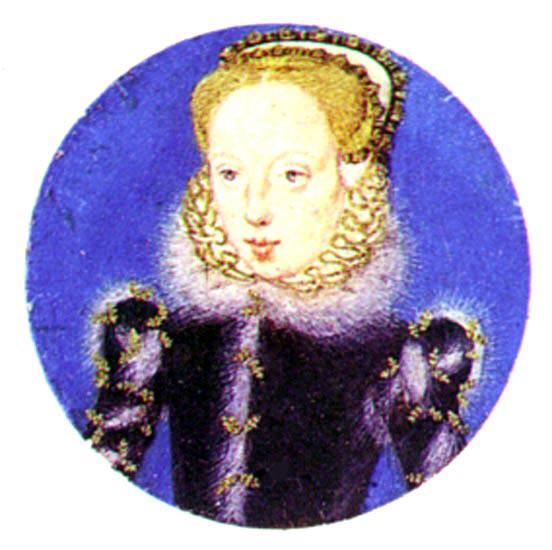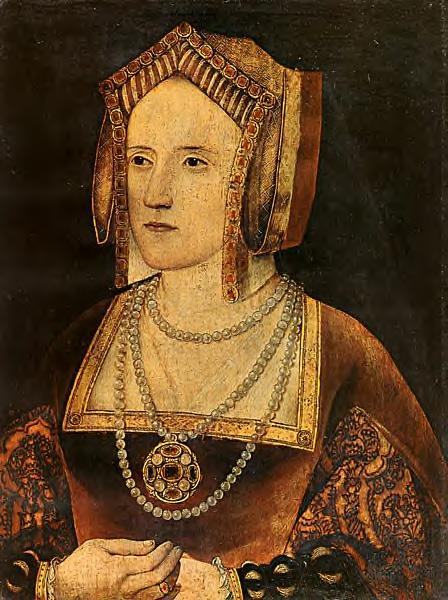Jane's early childhood
- till Henry VIII's death in 1547 -
Henry and Frances Dorset were robust and energetic. They spent a great deal
of time out of doors and lead a healthy, busy life. The routine that suited
them was sometimes too strenous for their daughters, of whom much was required,
with the result that both Katherine and Jane were apt to succumb to nervous
exhaustion. Mary's birth amounted almost to a disaster: she was a hump-backed
dwarf and was very ugly. but although she might prove, in spite of her Tudor
blood, to be unmarriageable, they did their best for her by giving her the
same education as her sisters and took her about with them. But her futur
remained a problem.
 Katherine was the beauty of the family.
Jane was small, light-haired and neatly made. Her skin was very fair and
soon became permanently freckled. But as soon as she passed the first stage
of her education she showed herself to be gifted in so many ways that her
freckles were overlooked.
Katherine was the beauty of the family.
Jane was small, light-haired and neatly made. Her skin was very fair and
soon became permanently freckled. But as soon as she passed the first stage
of her education she showed herself to be gifted in so many ways that her
freckles were overlooked.
Jane was treated as a princess. She and her sisters took their mother's rank;
she was adressed as "the Lady Jane", met the King's daughters on equal terms
and received the same training. Her background and way of life were more
luxurious than those of Mary and Elizabeth, who were brought up economically
and sometimes in real hardship. Bradgate was palatial. Its interiors reflected
the magnificence, and the modernity, of its outward planning. Dorset's father
had been one of the pioneers of the new architecture which provided homes
built for the enjoyment of wealth and ease, without regard of defence.
Those who, like the Dorsets, had resident physicians and were able to consult
the King's doctors if they wished, were in fact less fortunate than the poorer
classes with their homeopathy and herbal remedies. For English medical standards
were very low. This may partly have accounted for the tuberculosis which
killed Katherine at twenty-eight, and for Jane's nervous debility.
Yet the time-table they began to follow as soon as they could read - from
the age of three or four - was not really taxing, for they kept early hours
and had plenty of sleep. In country-houses the day began with prayers at
six, followed by a breakfast of bread, ale and meat. The young people, having
visited their parents, then worked at Greek and Latin till dinner-time. Music,
modern languages and classical or Biblical reading lasted till supper; then
the girls danced or sat down to their needlework before going to bed at nine.
Once or twice a week this programme might be set aside for a whole day's
hunting, hawking, or an expedition into Leicester, to be entertained by the
mayor and the local gentry.
In her sixth year Lady Jane can be visualized as a girl of twelve or thirteen
would be today, able to interchange a few simple Latin phrases and to read
Coverdale's Bible to herself. Her nurse, Mrs Ellen, was now her attendant,
and helped her other maids to dress her in clothes which exactly copied her
elders. In the 1540s these were very elaborate. her favourite hobby was music.
She would have liked to practise lute, harp and cithern for more hours than
were allowed, and became interested in composition. In her seventh year her
first tutor, Dr Harding, began her Greek, Spanish, Italian and French
lessons; these had to be fitted in with the writing-master's visits and the
time spent learning, not only the Court galliards and pavanes themselves,
but the symbolism underlying their movements. It was a full life and, in
spite of Frances' harshness, perhaps even a happy life. Then, between her
eighth and ninth birtdays, the pattern changed. Her parents' plans for her
future materialized. She was sent away from home for two years.
 The English custom of boarding out young children consisted
of sending those children to larger and wealthier establishments so that
they might acquire the habits of the fashionable world. As the Dorsets' position
was one of the highest, the only way of raising Jane's social status was
to place her with Queen Katherine Parr. They therefore brought her
to the notice of the King as soon as it was feasible. The Lady Frances, who
was frequently at Court, made it her business to be on friendly terms with
the Queen. By the time Henry VIII's health began to fail, and he withdrew
from the bustle of Westminster and Whitehall to the comparative seclusion
of Windsor and Hampton Court - between the spring of 1546 and his death in
January 1547 - the tenor of life in his palaces had so changed that it would
have been difficult to introduce his great-niece into the Queen's household.
Although it is not clear when Jane left Bradgate, she became known to the
Queen, Prince Edward and the Princesses before Henry died. By the time the
boy King succeeded and his step-mother had taken up partial residence at
Chelsea Palace, Jane had joined her household, and was given precedence of
all but her cousins as a princess of the blood.
The English custom of boarding out young children consisted
of sending those children to larger and wealthier establishments so that
they might acquire the habits of the fashionable world. As the Dorsets' position
was one of the highest, the only way of raising Jane's social status was
to place her with Queen Katherine Parr. They therefore brought her
to the notice of the King as soon as it was feasible. The Lady Frances, who
was frequently at Court, made it her business to be on friendly terms with
the Queen. By the time Henry VIII's health began to fail, and he withdrew
from the bustle of Westminster and Whitehall to the comparative seclusion
of Windsor and Hampton Court - between the spring of 1546 and his death in
January 1547 - the tenor of life in his palaces had so changed that it would
have been difficult to introduce his great-niece into the Queen's household.
Although it is not clear when Jane left Bradgate, she became known to the
Queen, Prince Edward and the Princesses before Henry died. By the time the
boy King succeeded and his step-mother had taken up partial residence at
Chelsea Palace, Jane had joined her household, and was given precedence of
all but her cousins as a princess of the blood.
Her education was thenceforth set in a mould which suited her so well that
she never diverged from it. Her establishment in the Queen's circle came
at the impressionable age of nine and a half, and its influence prevailed
on throughout her life. Katherine Parr, one of the most intelligent and charming
women of her day, was, temperamentally, the antithesis of Jane's mother Frances.
That Jane became attached to her is obvious, if only her letters and conversation
were to reflect those of her kind and gentle patroness, whose character and
career were a typical product of the English Reformation.
When she married Henry VIII in July 1543, Katherine Parr was thirty and had
been widowed twice. Her first husband was Lord Borough, her second
Lord Latimer. Childless, elegant, wealthy and accomplished, she was
an ideal wife and stepmother. After Lord Latimer's death she was converted
to Protestantism, and her house at Wimbledon became the center of an advanced
and learned coterie which included Coverdale, Cranmer and Anne
Askew. During this time Katherine was courted by and fell in love with
Thomas Seymour, Lord High Admiral of England and the brother of the
late Queen Jane Seymour, Edward VI's mother. Katherine had been on the point
of accepting him when Henry VIII required her hand. So the Admiral, whose
career was disastrously intermingled with that of Lady Jane, had to be dismissed.
Although he was attached to the Court and well-treated by the King, his position
and power counted as nothing beside those of his elder brother, Edward
Seymour, who, at his nephew's accession, became Duke of Somerset and
Protector of the realm.
To Biography part 3 - Jane and the
Seymours
Back to Biography
Back to main page